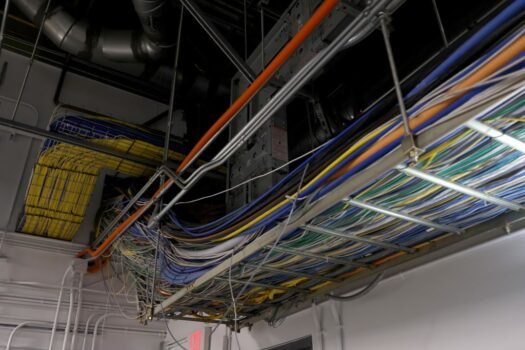Hard facts about data centers are tough to find in California because most rent out power, cooling and floor space to other companies, said Ren, the UC Riverside researcher. Such colocation facilities don’t run their own servers or technology, so they report less information publicly than data centers built by major tech companies in other states.
While estimates vary, California has the third-most data centers in the country, after Texas and Virginia. DataCenterMap, a commercial directory that tracks data centers worldwide, lists 321 sites across the state. More in California are expected in coming years.
The centers operate around the clock and often rely on diesel backup generators to maintain service during power failures — a practice that adds both greenhouse gases and local air pollutants. They also consume energy and water depending on their cooling methods.
Rising data-center demand, and rising questions
F. Noel Perry, the businessman and philanthropist who founded Next 10, said his organization’s report shines light on what is fundamentally a black box. “To solve a problem, we have to understand what the problem is,” he said.
“We’ve seen the proliferation of data centers in California, in the U.S. and across the world — and we also are seeing major implications for the environment,” Perry told CalMatters. “The real issue has to do with transparency — and the ability of elected officials and regulators to create some rules that will govern reductions in emissions, water consumption.”
The report estimated that data centers used 10.8 terawatt-hours of electricity in 2023, up from 5.5 terawatt-hours in 2019, accounting for 6% of the nation’s total data center energy use. Unless growth is curbed or better managed, the report’s authors project demand could rise to as high as 25 terawatt-hours by 2028, equal to the power use of roughly 2.4 million U.S. homes.
Carbon emissions from the sector nearly doubled during the same period, climbing from 1.2 million to 2.4 million tons, researchers estimated, while on site water use grew from 1,078 acre feet in 2019 to 2,302 acre feet in 2023. That’s enough to meet the annual water needs of almost seven thousand California households.
The report’s authors also estimated the public health costs from air pollution associated with data centers have potentially risen, from $45 million in 2019 to more than $155 million in 2023, with the burden expected to reach as high as $266 million by 2028.
Most of those costs stem from indirect pollution produced by fossil-fueled power plants that supply the grid. But authors pointed out that regions dense with data centers — particularly Santa Clara County, home to Silicon Valley — could face higher localized risks from diesel backup generators.
Dan Diorio, vice president of state policy for the Data Center Coalition, said the report exaggerates the impact of backup diesel generators, which are tightly regulated and rarely used in California, minimizing their contributions to air pollution. Data centers don’t control the water used in electricity generation, said Diorio. Since those water impacts don’t happen on site, it’s not fair to blame that on the centers themselves.
“It paints a skewed picture of this critical 21st-century industry,” Diorio said in a statement.
Diorio said the report also overlooks how cooling technology varies by region and has become more efficient in recent years.
But the authors say their findings underscore the need for uniform reporting standards for data centers’ energy and water use. The report said California should establish ongoing local monitoring and review of data centers — and make the findings public.
Ren, the UC Riverside researcher, said that California’s cleaner grid and stricter pollution rules are helping blunt some environmental impacts of data centers already.








